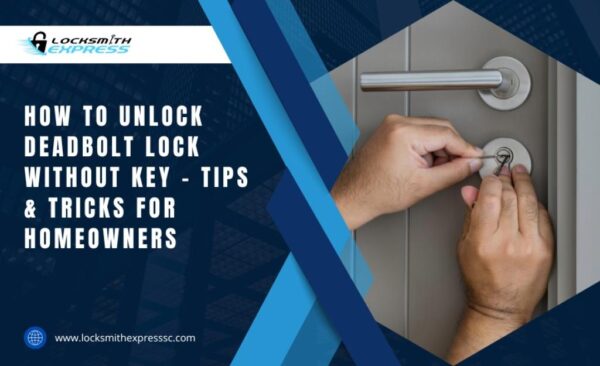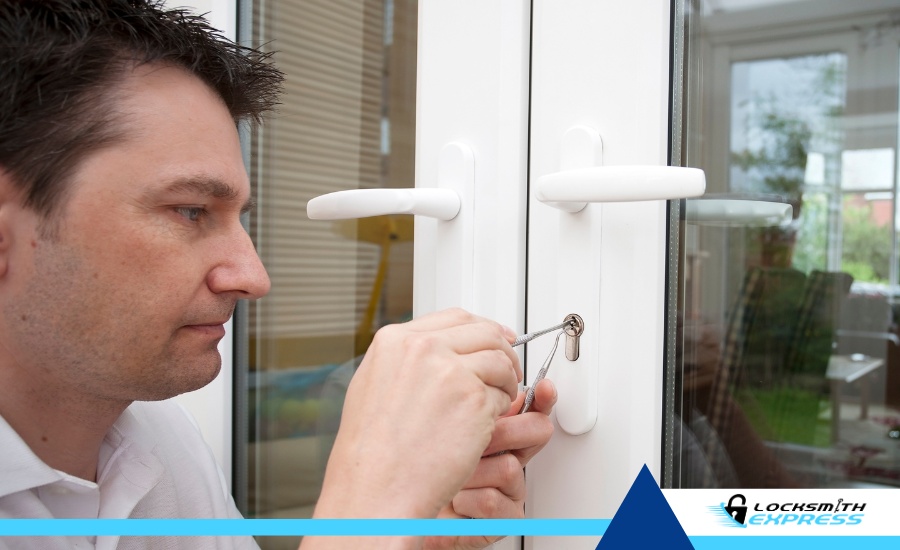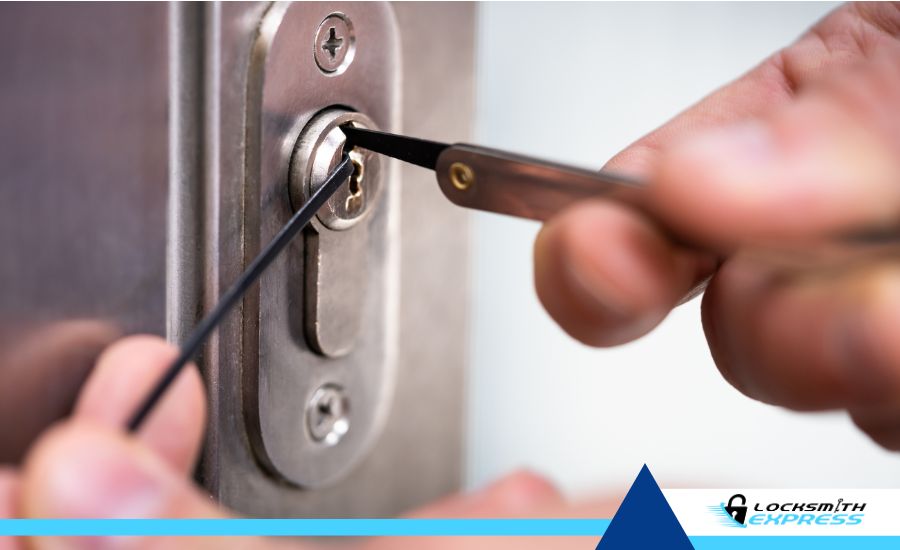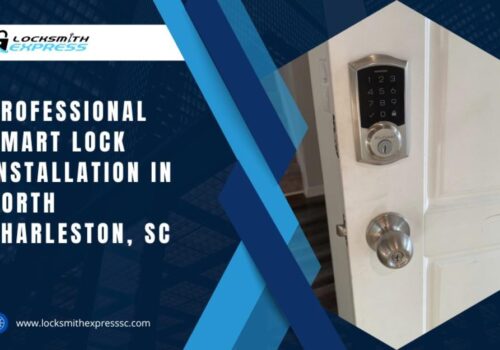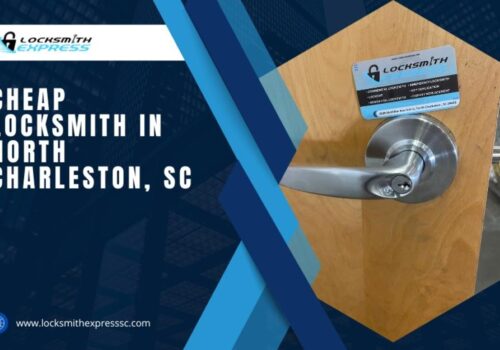Finding yourself locked out of your home can cause more than just inconvenience; it can completely disrupt your day and leave you feeling helpless, especially when dealing with a deadbolt lock, known for its robustness and security. That's where locksmith services come in handy. In this guide, we'll dive into the world of deadbolt locks, a popular lockset type among homeowners, and reveal some practical tips and tricks on how to unlock a deadbolt lock without a key.
- Understanding Deadbolt Locks
- Anatomy of a Deadbolt Lock
- Why Deadbolts are a Popular Choice for Home Security
- Essential Tools for Unlocking a Deadbolt
- Common Household Items That Can Be Used
- Professional Lock-Picking Tools
- Techniques to Unlock a Deadbolt Without a Key
- DIY Methods: Paperclips, Bobby Pins, and Credit Cards
- Step-by-Step Lock Picking Guide for Beginners
- Advanced Lock-Picking Techniques
- Understanding Bumping and How It Works
- Electronic Lock Picks: Pros and Cons
- Non-Destructive Entry Methods
- Bypassing the Lock Mechanism Safely
- When to Call a Professional Locksmith
- Recognizing Complex Lock Mechanisms
- Benefits of Hiring a Certified Locksmith
- Up-to-date with the Latest Security Trends
- Enhancing Your Home's Security Post-Entry
- Upgrading to High-Security Deadbolt Locks
- Integrating Smart Locks for Keyless Access
- Legal and Ethical Considerations of Lock Picking
- Understanding Local Laws and Regulations
- Ethical Practices in Emergency Situations
- Preventive Measures to Avoid Future Lockouts
- Key Duplication and Storage Tips
- Implementing Routine Lock Maintenance
- A Responsible Approach to Locksmithing
- Frequently Asked Questions
- Can a deadbolt be unlocked without a key?
- Are DIY methods safe for unlocking deadbolt locks?
- What are the risks of lock picking?
- How can I prevent accidental lockouts in the future?
- Is it legal to pick your house lock?
- Paperclips
- Bobby Pins
- Credit Cards
- Get Expert Help from Locksmith Express, North Charleston
Have you ever wondered how a deadbolt works? Unlike regular locks, deadbolts provide an added layer of security. They extend deeper into the door frame, making them more resistant to external force. This is why deadbolts are a cornerstone of home security systems. However, their robustness also means they can be tricky to unlock if you find yourself without a key.
But don't worry! Whether you've lost your keys or just want to be prepared for a lockout situation, we've got you covered. Here's a sneak peek of what you'll learn:
- Unlocking Techniques Using Household Items: Discover how everyday objects can become your DIY lock-picking tools.
- Professional Insights into Lock Picking: Learn the basics and get a glimpse into advanced methods.
- Safe Non-Destructive Entry Methods: Understand how to unlock your door without damaging the lock.
- When to Call a Professional: Know the signs that indicate it's time to get expert help.
By the end of this guide, you'll better understand your deadbolt lock and feel equipped to tackle a lockout scenario. So, let's unlock the mystery of deadbolt locks and turn this potentially stressful situation manageable. Keep reading to become more knowledgeable and prepared as a homeowner!
Understanding Deadbolt Locks
Deadbolt locks, often simply called deadbolts, are a familiar sight in homes across the globe. Their popularity isn't a stroke of luck but a testament to their reliability and robustness in providing home security. But what exactly makes a deadbolt different from other lockset types? Let’s break it down.
Anatomy of a Deadbolt Lock
At its core, a deadbolt is designed for strength. Unlike spring bolt locks, which use a spring to hold the bolt in place, deadbolts require manual operation, either by a key or a knob. This mechanism includes several key components: the lock body, the cylinder where the key is inserted, and the bolt, which is the metal piece that extends out of the lock to secure the door.
When you turn the key or the knob, the cylinder activates the bolt, extending it into the door frame's strike plate. This action is what locks the door. What sets deadbolts apart is the bolt's length and strength. It extends further into the door frame, making it resistant to forced entry methods like kicking or using a crowbar. Some deadbolts even feature saw-resistant bolts with anti-cutting pins inside them, thwarting any attempt to see through the bolt.
Why Deadbolts are a Popular Choice for Home Security
The superiority of deadbolts in home security can be attributed to their design and functionality. Their solid construction makes them a strong barrier against intruders. Unlike regular locks that can be easily compromised with techniques like lock bumping or lock picking, deadbolts provide higher security.
One key aspect that homeowners appreciate is the deadbolt's resistance to "lock snapping" – a method where intruders break the lock cylinder in half to manipulate the lock. Due to the reinforced design of deadbolts, they are much harder to snap. This durability makes them essential for home security locks and residential lock solutions.
Another reason for their popularity is the variety available. Deadbolts come in different forms – single cylinder, double cylinder, and lockable thumb turn. Single-cylinder deadbolts are more common in residential settings. They have a key cylinder on the outside and a thumb turn on the inside. This design allows easy exit in case of emergencies like fires. Double-cylinder deadbolts, which require a key on both sides, offer higher security but can pose a safety risk during emergencies. The lockable thumb turn offers a middle ground, combining the convenience of a thumb turn with the security of a double cylinder.
Moreover, deadbolt installation is straightforward, which adds to their appeal. Most homeowners can install them with basic tools and little expertise, although professional installation is recommended for optimal security. Additionally, deadbolts can be integrated into high-security deadbolt options and smart lock systems, offering a blend of traditional security and modern convenience.
Essential Tools for Unlocking a Deadbolt
Unlocking a deadbolt lock without a key might sound like a task for a professional locksmith, but with the right tools and techniques, it's something that you can manage on your own. In this section, we'll explore common household items and professional lock-picking tools that can be used to unlock a deadbolt. Understanding these methods can be incredibly useful in an emergency lockout situation.
| Tool Type | Tools | Pros | Cons |
| DIY Tools | Bobby Pins | Easily available, and inexpensive. Can be molded into a shape for lock picking. | Requires skill and practice. May not work on more complex locks. Risk of damaging the lock or tool. |
| Paperclips | Widely available, can be reshaped as needed. Good for basic lock picking. | Less durable than professional tools. Limited effectiveness. | |
| Credit Card | A quick method for spring latch locks, not deadbolts. Non-damaging to the lock. | Ineffective on deadbolts. Could damage the card. | |
| Screwdrivers | Common household item. Can be used as a tension wrench. | Improper use can damage the lock. Not suitable for actual picking. | |
| Professional Tools | Lock Pick Set | Designed for lock picking. Variety of picks for different lock types. Greater success rate. | Requires training to use effectively. Can be expensive. |
| Electric Pick Gun | Efficient, fast. Good for a variety of locks. Reduces manual effort. | Requires skill and practice. Higher cost. May be illegal in some regions without a locksmith license. | |
| Bump Key | Effective on many locks. Relatively easy to use with some practice. | Illegal in some areas. Requires specific keys for different locks. | |
| Snap Gun | A quick method to open locks. Less skill-intensive compared to traditional lock picks. | More expensive than manual picks. Can damage the lock if used improperly. |
Common Household Items That Can Be Used
Believe it or not, you might already have everything you need to unlock a deadbolt right in your home. These everyday items are surprisingly effective for DIY lock picking:
- Bobby Pins: A staple in most homes, bobby pins can be bent into a makeshift lock pick and tension wrench. Straighten out two bobby pins, bend a small W at the end of one (this will be your pick), and a 90-degree angle on the other (your tension wrench).
- Paperclips: Similar to bobby pins, paperclips can be reshaped to pick a lock. You'll need two: one bent straight with a small upward bend at the end and the other at a right angle.
- Credit Card: While not effective on deadbolts, a credit card can be used on spring latch locks, a common companion to deadbolts on many doors. Slide the card between the door and the frame, then wiggle and push it down to force the latch back into the door.
- Screwdrivers: Small flat-head screwdrivers can be used as a tension wrench, paired with a bobby pin or paperclip pick.
Remember, while these methods can be handy in a pinch, they require patience and a gentle touch. Forcing or rushing can damage the lock or the tool you're using.
Professional Lock-Picking Tools
For those who prefer a more reliable and efficient method, professional lock-picking tools are the way to go. These tools are designed specifically for unlocking locks and offer a higher success rate than improvised tools. Here are some of the most common tools locksmiths use:
- Lock Pick Set: A standard set includes a variety of picks and a tension wrench. Each pick is designed for different lock types and mechanisms.
- Electric Pick Gun: This tool vibrates and moves the pins in the lock as you apply tension, which can quickly open the lock. It's more advanced but highly effective.
- Bump Key: Made to fit the most common types of deadbolts, a bump key can unlock a lock by 'bumping' the pins to the shear line. It requires some skill to use effectively.
- Snap Gun: Similar to an electric pick gun, a snap gun uses a sharp snapping motion to bump the pins, allowing for quick unlocking.
Using professional tools requires knowledge and practice. They're more efficient but also come with a higher responsibility to use them ethically and legally.
Techniques to Unlock a Deadbolt Without a Key
Sometimes, finding yourself locked out of your home can happen when you least expect it. In such moments, knowing a few DIY methods to unlock a deadbolt without a key can be a real lifesaver. While these techniques require patience and practice, they can be quite effective. Let’s explore how everyday items like paper clips, bobby pins, and credit cards can come to your rescue.
DIY Methods: Paperclips, Bobby Pins, and Credit Cards
Paperclips
These common office supplies can be transformed into a makeshift lock-picking tool. First, straighten two paper clips. Bend one into an 'L' shape - this will serve as your tension wrench. The other one should have a small bend at the end, acting as your pick. Insert the tension wrench into the bottom part of the keyhole and apply slight pressure in the direction the key would turn. With the other paperclip, gently probe the pins inside the lock, feeling for resistance. When you push up the right pin to the correct height, the lock will turn slightly. Repeat this with all the pins until the lock turns fully.
Bobby Pins
Similar to paper clips, bobby pins are another handy tool for emergency lock picking. Start by removing the rubber tip from one of the pins and straightening it out. Bend a small portion at the end to create your pick. Use another bobby pin as your tension wrench by bending it into an 'L' shape. The process of picking the lock is similar to using paper clips. Insert the tension wrench, apply pressure, and carefully pick the pins with the bobby pin.
Credit Cards
While credit cards are ineffective for unlocking deadbolts, they can be used for spring latch locks, often found alongside deadbolts on doors. To use a credit card, slide it between the door and the frame where the latch is located. Tilt the card towards the doorknob and bend it back to force the latch into the door. This method requires caution to avoid damaging the card or the lock.
These DIY methods are useful in a pinch but aren't foolproof. Different deadbolts have different levels of complexity, and some might be more challenging to unlock than others. Additionally, while these methods can be helpful in emergencies, they should be used responsibly and legally. It's important to remember that these techniques are meant for getting into your own home when you're locked out and should never be used on someone else's property without permission.
Step-by-Step Lock Picking Guide for Beginners
Here’s a beginner-friendly guide to lock picking that can help you understand the essentials of this useful skill. Remember, this guide is for educational purposes and should be used ethically and legally.
Understanding the Lock Mechanism
Before you start, it's crucial to understand how a lock works. A typical pin tumbler lock, commonly used in deadbolts, consists of a series of pins pushed down by springs. When the correct key is inserted, it aligns these pins at a specific height, allowing the lock to turn.
Tools You’ll Need
For basic lock picking, you'll need a pick and a tension wrench. You can create these from paper or bobby pins, as mentioned earlier, or use professional lock-picking tools if available.
- Inserting the Tension Wrench: The tension wrench is used to apply torque to the lock cylinder. Insert the shorter end of your tension wrench into the bottom part of the keyhole. Apply gentle, steady pressure in the direction you would turn the key. This tension is critical in keeping the pins in place once they are set at the correct height.
- Using the Pick: With your other hand, insert the pick into the top part of the keyhole. Your goal is to push the pins up to align them at the shear line, where the lock's inner cylinder and outer housing meet.
- Identifying and Setting Pins: Feel for the pins with your pick. You'll notice they spring back when you push them. Gently push up each pin, starting from the front of the lock. As you push a pin to the correct height, you’ll feel a slight movement in the tension wrench, and the lock will turn slightly.
- Repeat Until All Pins Are Set: Continue pushing each pin-up, maintaining constant pressure with your tension wrench. If the lock doesn’t open, release the tension slightly, and start again. Lock picking requires patience, so don’t get discouraged if it doesn’t work immediately.
- Opening the Lock: Once all the pins are set at the correct height, the tension wrench will turn the cylinder, and the lock will open.
Common Challenges and Tips
- Feeling the Pins: Initially, it might be difficult to differentiate between the pins. Practice will help you get a better feel for this.
- Applying the Right Amount of Tension: Too much tension can make it hard to move the pins, while too little won’t hold the pins in place. Finding the right balance is key.
- Patience is Essential: Lock picking is a skill that requires practice. Don’t be discouraged if you don’t succeed right away.
Remember, lock picking is a skill that should be used responsibly. It’s meant for getting into your property or helping others with their permission. Misusing this skill can lead to legal consequences.
Advanced Lock-Picking Techniques
While basic lock-picking skills can be handy, sometimes they might not be enough, especially with more complex locks. This is where advanced techniques like lock bumping come into play. Lock bumping is a method that can be used to open many pin tumbler locks, which are commonly found in deadbolts. It's a technique often used by locksmiths but has also gained popularity among DIY enthusiasts.
Understanding Bumping and How It Works
Lock bumping involves using a specially cut key, known as a bump key, to align the pins inside a lock without the original key. This technique works on the principle that applying a certain amount of force will cause the pins in the lock to jump momentarily, allowing the lock to be turned.
Creating a Bump Key
A bump key is made by cutting down a key blank to its lowest depth. Each cut in the key corresponds to a pin in the lock. When inserted into the lock, it sits just below the pins.
The Bumping Process
- Insert the Bump Key: First, insert the bump key into the lock, but not all the way. Leave one pin out so that the key can slide in further when you apply force.
- Apply Pressure: Apply slight turning pressure on the key, similar to how you would turn a normal key.
- Bump the Key: Strike the end of the key with an object like a screwdriver handle or a small hammer. The force from the strike pushes the key deeper into the lock, causing the pins to jump.
- Turn the Lock: As you bump the key, maintain the turning pressure. If timed correctly, the lock will turn as the pins jump, aligning at the shear line.
Safety and Legal Considerations
It’s important to note that lock bumping should be done carefully to avoid damaging the lock. Also, like all lock-picking techniques, it should only be used for legal purposes, such as gaining entry to your property or with explicit permission from the owner.
Understanding Bumping is Important
Even if you don’t plan to use bumping yourself, understanding this technique is important for homeowners. It highlights a potential vulnerability in your home security, as bumping can be a silent and quick way for burglars to gain entry. Knowing about it can guide you in choosing bump-proof locks or upgrading your home security system.
Lock bumping is a clear example of how understanding advanced lock-picking techniques can be beneficial, not just for unlocking doors but also for enhancing the security of your home. In the next section, we will delve into the world of electronic lock picks, offering insight into how technology is changing the landscape of lock picking and home security.
Electronic Lock Picks: Pros and Cons
An electronic lock pick is one of the more advanced tools in a locksmith's arsenal. These devices have changed how professionals approach lock picking, especially when dealing with complex lock systems. Let's explore the advantages and disadvantages of using electronic lock picks.
What are Electronic Lock Picks?
Electronic lock picks use motorized or electronic components to manipulate the pins inside a lock. Unlike manual picking, where each pin is set individually, electronic picks work by rapidly moving all the pins at once. This action often results in the lock opening much quicker than traditional methods.
Pros of Electronic Lock Picks
- Efficiency: One of the biggest advantages of electronic lock picks is their efficiency. They can open locks much faster than manual picking methods.
- Ease of Use: These devices require less skill and precision than manual lock picks. They do most of the work for you, making lock picking more accessible, especially for beginners.
- Effectiveness on Complex Locks: Electronic lock picks are particularly effective on locks with more pins or complex mechanisms, where manual picking might be challenging.
- Reduced Physical Effort: Electronic picks reduce the physical strain associated with manual picking for locksmiths or individuals who frequently deal with lockouts.
Cons of Electronic Lock Picks
- Cost: Electronic lock picks are generally more expensive than traditional lock-picking tools. This can be a significant factor for occasional users or DIY enthusiasts.
- Power Dependency: Being electronic, these tools require a power source, either batteries or a direct power connection. This dependency can be a drawback in situations where power access is limited.
- Potential for Damage: If not used correctly, the rapid movement and force applied by electronic picks can damage the lock.
- Legal Restrictions: In some areas, possession of electronic lock-picking tools is restricted to licensed professionals. It’s important to know and comply with local laws regarding these tools.
Balancing the Pros and Cons
When deciding whether to use an electronic lock pick, consider the situation at hand. For complex locks or in a professional setting, the efficiency and ease of use can be a significant advantage. However, for occasional use or simple lock types, the cost and potential for overkill might not justify their use.
Non-Destructive Entry Methods
When you're locked out, the last thing you want is to damage your door or lock. That's where non-destructive entry methods come in handy. These techniques allow you to bypass the lock mechanism safely, ensuring that you can gain entry to your home without causing damage. Let's explore some of these methods, focusing on safety and effectiveness.
Bypassing the Lock Mechanism Safely
Slip Method
This method works best on doors with a simple latch rather than a deadbolt. The idea is to slide a thin, flexible tool, like a plastic card, between the door and the frame. By angling the card towards the latch and pushing it in, you can push the latch back and open the door. While this method won't work on a deadbolt, it's a good trick for spring latch locks.
Under the Door Tool
For doors that have a handle with an exposed lever or thumb turn on the inside, an under-the-door tool can be used. This long, flexible tool slips under the door and hooks around the handle or thumb turn, pulling it to open the door from the inside. It's a clever way to gain entry without affecting the lock itself.
Bypassing Keyed Alike Systems
In some homes or apartments, the same key might operate multiple locks. If you have access to another door with the same key system, you can open it and access the locked area from inside. This method requires that you have an alternate entry point and that the locks are keyed alike.
Locksmith Tools
Professional locksmiths use various non-destructive tools, such as lock picks and bump keys, which can open locks without damaging them. If you’re not confident in your lock-picking skills or if the lock is particularly complex, calling a professional is the safest choice.
Using Locksmith Services
A professional locksmith not only has the right tools but also the expertise to open locks without causing damage. They can handle a variety of lock types and can provide a quick, safe solution to your lockout situation.
Ethical Considerations
It's crucial to use these methods only on locks that you own or have permission to open. Unauthorized use of these techniques can be illegal and unethical.
Ethical Considerations in Lock Picking
Lock picking should only be done as a means to enter your own home during an emergency lockout. It comes with significant ethical considerations. It's not just about having the skill to manipulate a lock but also understanding the responsibility that comes with this knowledge. Let's explore the ethical aspects of lock picking, ensuring that this skill is used appropriately and legally.
Legal Implications
It’s important to know that lock-picking laws vary by location. In some places, possessing lock-picking tools without a locksmith license can be illegal. Always check local laws and regulations before engaging in lock picking. The intent is also a key legal factor – using these skills to break into property that you don't own or without permission is a criminal act.
Consent is Crucial
Always have explicit permission to pick a lock that isn't yours. Whether it's helping a neighbor or a friend, getting verbal or written consent is a legal safeguard and a matter of respect and trust.
Privacy and Trust
Respecting privacy is a cornerstone of ethical lock-picking. If you have the skill to pick locks, it’s crucial to be mindful of the trust people place in you. This means not picking locks you don’t have permission to, and respecting people's privacy and property.
Responsible Learning and Practice
When learning and practicing lock picking, it’s best to use your practice locks. Avoid practicing on locks that are in use, such as your front door lock, as repeated picking can wear down the mechanism and potentially damage it.
Sharing Knowledge Responsibly
If you’re teaching someone else how to pick locks, make sure they understand the legal and ethical implications. Passing on this knowledge comes with the responsibility to emphasize its ethical use.
Lock Picking as a Profession
Professional training and certification is important for those considering a career as a locksmith. This formal education not only teaches technical skills but also covers the legal and ethical aspects of the profession.
Community Standards
The lock-picking community, including hobbyist groups and professional associations, often has standards and codes of conduct. These standards are designed to promote responsible and ethical practice within the community.
Use in Emergencies
Using lock-picking skills in emergencies, like helping someone who's locked out of their home, can be a gray area. Even in these cases, it’s important to ensure that you have clear permission and that your help is genuinely needed.
Respect for Security
Remember that locks are designed to provide security and privacy. Ethical lock picking respects the purpose of a lock and the security it provides to individuals.
When to Call a Professional Locksmith
Dealing with a lockout can be a stressful experience, and while DIY methods can be helpful, there are times when calling a professional locksmith is the best course of action. One such situation is when you're faced with complex lock mechanisms. Understanding the intricacies of different locks and knowing when to seek professional help can save you time and prevent potential damage to your lock or door.
Recognizing Complex Lock Mechanisms
High-Security Locks
Some homes and businesses use high-security locks for enhanced protection. These locks often have features like anti-pick pins, security plates, or unique keyways that make DIY methods ineffective. If your door is equipped with a high-security lock, it's best to call a locksmith. Trying to pick these locks without proper skills can result in damaging the lock and potentially increasing the cost of repair or replacement.
Electronic or Smart Locks
The rise of home automation has led to the popularity of electronic and smart locks. These locks might use keypads, biometric scanners, or remote control functions, making them more complex than traditional locks. If you're locked out due to a malfunction or a forgotten code, a locksmith with experience in electronic lock systems is necessary. They have the tools and expertise to diagnose and fix the issue without damaging the sophisticated mechanisms.
Old or Damaged Locks
Older locks, or those exposed to wear and tear, might require special attention. If a lock is rusty, has a broken key inside, or has been damaged in any way, it's safer to call a professional. Locksmiths can handle these delicate situations with the right tools and techniques, ensuring the lock's integrity isn't further compromised.
After a Break-In
In the unfortunate event of a break-in or attempted break-in, contacting a locksmith is crucial. They can assess the damage, repair or replace compromised locks, and provide recommendations for enhancing your home's security. They can also install new locks that might be more resistant to tampering or forced entry.
For Lock Installation or Upgrade
If you're considering installing new locks or upgrading your current security system, a locksmith’s expertise can be invaluable. They can advise on the best types of locks for your needs and ensure that they are installed correctly, providing you with peace of mind about your home's security.
Complex Key Systems
For properties with a master key system or key control systems, managing and repairing these setups usually requires a professional locksmith. They can handle the intricacies of these systems, ensuring that all locks and keys function as intended.
Knowing when to call a professional locksmith is crucial, especially when dealing with complex lock mechanisms. While it might be tempting to tackle the problem yourself, a trained and experienced locksmith can provide a safe, efficient, and effective solution, ensuring your home's security and peace of mind.
Benefits of Hiring a Certified Locksmith
Hiring a certified locksmith offers several advantages, especially when you're dealing with lockouts, needing lock repairs, or considering upgrading your home security. These professionals are not only trained in the art of lock picking but also bring a wealth of knowledge and expertise in various aspects of security. Let's delve into the benefits of having a certified locksmith on your side:
- Trained and Experienced - Certified locksmiths have undergone extensive training. They are skilled in handling a variety of locks and security systems, ensuring that whatever your issue, they have the knowledge to address it.
- Proper Tools and Equipment - Locksmiths come equipped with the right tools for every job, which means they can handle lockouts or installations efficiently and without damaging your property.
- Quick Response Time - Many locksmiths offer emergency services, meaning they can respond quickly to your call. This is particularly important in lockout situations or security emergencies.
- Reliability and Trustworthiness - Certification adds a level of trustworthiness. Certified locksmiths are often required to pass background checks, ensuring they are reliable and safe to work with.
- Wide Range of Services - Professional locksmiths offer more than just lock picking. They provide a range of services, including lock installation, repair, key cutting, and security consultations.
Up-to-date with the Latest Security Trends
As security technology evolves, certified locksmiths keep up-to-date with the latest trends and tools, ensuring that they can handle even the most modern locks and security systems.
- Insurance and Accountability - Certified locksmiths are usually insured, which means any accidental damage during the job is covered. This provides an extra layer of protection for the homeowner.
- Peace of Mind - Knowing that a skilled professional is handling your lock and security needs provides peace of mind, which is invaluable.
- Customized Security Advice - Locksmiths can assess your home’s security needs and provide tailored advice on how to enhance your safety.
- Availability for Future Needs - Once you find a locksmith you trust, you can rely on them for future security needs, whether it’s an emergency lockout or a planned security upgrade.
Hiring a certified locksmith ensures that you receive professional, efficient, and reliable service. Their expertise and tools make them an invaluable resource for tackling a variety of security challenges, giving you peace of mind and keeping your property safe and secure.
Enhancing Your Home's Security Post-Entry
After addressing a lockout situation, it's a good opportunity to reassess and possibly upgrade your home's security. Enhancing lock security not only deters potential break-ins but also provides peace of mind. Let's look at two effective ways to boost your home security: upgrading to high-security deadbolt locks and integrating smart locks for keyless access.
Upgrading to High-Security Deadbolt Locks
High-security deadbolt locks are a significant upgrade from standard locks. They offer advanced features that make them more resistant to common burglary methods like lock picking, bumping, or drilling.
- Complex Lock Mechanisms: High-security locks often have complex pin configurations, making them incredibly difficult to pick. They may include features like spool pins or mushroom pins that respond differently than standard pins, confounding attempts at lock picking.
- Reinforced Design: These locks typically have stronger, reinforced designs. They often come with hardened steel inserts and anti-drill plates that resist drilling attacks.
- Key Control: High-security locks often require unique keys that can't be easily duplicated. This control over who can make copies of your keys adds an extra layer of security.
- Durability: Made with high-quality materials, these locks are built to last and can withstand significant wear and tear over time.
Upgrading to a high-security deadbolt lock is a straightforward way to enhance your home's security, especially if you've experienced a lockout or break-in attempt. It's an investment in your safety and peace of mind.
Integrating Smart Locks for Keyless Access
Smart locks are a modern solution that offers convenience and enhanced security. They allow keyless entry and provide various features that traditional locks can't match.
- Remote Access: Many smart locks can be operated remotely through a smartphone app. This feature allows you to lock or unlock your door from anywhere, which is perfect for letting in guests or service professionals when you're not home.
- Customizable Access Codes: Instead of physical keys, smart locks often use access codes that can be customized and changed as needed. This eliminates the risk of lost or stolen keys.
- Access Logs: Smart locks can keep logs of who enters and leaves your home, giving you a clear record of access, which is valuable for security monitoring.
- Integration with Home Security Systems: Many smart locks can integrate seamlessly with your home's overall security system, including cameras and alarms, for a comprehensive security solution.
- Temporary Access: You can grant temporary access to people, like house sitters or dog walkers, without needing to make spare keys.
Smart locks represent the intersection of security and technology, offering a level of control and convenience that traditional locks can't. They are particularly useful for homeowners who value the blend of technology with security.
Legal and Ethical Considerations of Lock Picking
Lock picking, whether done as a hobby or a necessity, is not just about skill and technique; it's equally about understanding and adhering to legal and ethical guidelines. This knowledge is crucial, not only for staying within the boundaries of the law but also for maintaining high moral standards.
Understanding Local Laws and Regulations
The legality of owning and using lock-picking tools varies significantly from place to place. In some areas, possession of these tools without a locksmith license can be seen as intent to commit a crime. It's important to research and understand the laws in your area. This knowledge is essential for anyone interested in lock picking, whether as a hobby or profession.
- Possession vs. Intent - In many places, the legal issue with lock-picking tools comes down to intent. If you're found with these tools, you may need to prove that your intent was not to commit a crime. This is why understanding and following local laws is crucial.
- Licensing Requirements - If you're considering becoming a professional locksmith, be aware of the licensing requirements in your area. These often involve specific training, exams, and background checks.
Ethical Practices in Emergency Situations
- Consent is Key - Always ensure you have explicit permission to pick a lock that isn't yours. Whether it's a friend in need or a neighbor asking for help, getting consent is not just legally prudent; it's ethically right.
- Using Skills Responsibly - If you're skilled in lock picking, use this ability responsibly. This means never using your skills to take advantage of others or invade someone's privacy.
- Helping in Emergencies - In an emergency, such as helping someone locked out of their car or home, ensure that the situation truly is an emergency and that the person you're helping has a legitimate right to access the property.
- Respect for Privacy and Security - Lock-picking skills should be used with a high degree of respect for others' privacy and security. This means not picking locks to prove it can be done or out of curiosity.
Preventive Measures to Avoid Future Lockouts
Experiencing a lockout can be frustrating and inconvenient. However, with some proactive measures, you can significantly reduce the chances of it happening again. Let's explore practical steps you can take, focusing on key duplication and storage, as well as routine lock maintenance.
Key Duplication and Storage Tips
- Duplicate Your Keys: It's a smart idea to have a few spare keys. You can keep a set with a trusted family member or friend, or in a secure location. When duplicating your keys, ensure it's done by a reputable locksmith to guarantee accuracy.
- Use Key Holders: Consider using key holders or key safes. Key safes, which can be securely attached to your home, allow you to store a spare key outside in a combination-locked box. This method provides easy access while keeping your key secure.
- Creative Hiding Spots: If you prefer hiding a key outside, choose a spot that's not obvious. Avoid common places like under doormats or flowerpots. Instead, think of less conspicuous locations a good distance from your door.
- Key Finder Devices: For those who tend to misplace their keys, key finder devices can be a lifesaver. These small, attachable gadgets can be located using a smartphone app, making it easier to find lost keys.
Implementing Routine Lock Maintenance
- Regularly Check Lock Functionality: Periodically check your locks to ensure they are functioning properly. Look out for signs of wear or damage, such as difficulty turning the key or a loose handle.
- Lubricate Your Locks: Locks can become stiff or unresponsive due to lack of lubrication. Use a graphite or silicone-based lubricant on the keyhole a few times a year to keep the mechanism smooth.
- Tighten Loose Hardware: Over time, the screws and hardware of your lock and door handle can become loose. Tightening these ensures that your lock functions as intended and can prevent lockouts caused by hardware malfunction.
- Upgrade Aging Locks: If your locks are old or showing signs of wear, consider upgrading them. New locks can offer better security and functionality, reducing the likelihood of lockouts due to lock failures.
- Professional Lock Inspection: Having a professional locksmith inspect your locks can provide insights into potential issues. They can identify and fix problems that might
A Responsible Approach to Locksmithing
Learning how to unlock a deadbolt lock without a key can be a useful skill in certain situations. By using simple tools like a tension wrench and a lock pick, you can potentially gain access to your locked door. However, it's essential to remember that attempting to unlock a deadbolt without proper authorization may be illegal and unethical.
Locksmiths are trained professionals who can help you in situations where you're locked out or need assistance with your locks. It's always recommended to seek their assistance whenever possible. Additionally, maintaining good security practices and keeping spare keys in secure locations can help prevent lockouts in the first place.
Remember, the information provided here is for educational purposes only and should not be used for any illegal activities. Always prioritize safety, legality, and ethical considerations when dealing with locks and security.
Frequently Asked Questions
Can a deadbolt be unlocked without a key?
Yes, a deadbolt can be unlocked without a key, but it requires skill and the right tools. The most common methods include lock picking, using a bump key, or employing bypass techniques. Lock picking involves manipulating the lock's pins with tools like a tension wrench and pick. A bump key, designed to fit the specific deadbolt, can also be used to align the pins when struck. Bypass methods vary depending on the deadbolt's design but usually involve exploiting weaknesses in the lock. However, these methods should be used responsibly and legally, primarily to gain entry to your property in an emergency.
Are DIY methods safe for unlocking deadbolt locks?
DIY methods can be safe for unlocking deadbolt locks if done correctly and cautiously. Using household items like bobby pins or paperclips for lock picking is common. However, there's a risk of damaging the lock or the tool you're using. DIY methods require patience and a gentle touch. If you're unsure or uncomfortable with these methods, it's best to call a professional locksmith to avoid damaging your lock.
What are the risks of lock picking?
The risks of lock picking include potentially damaging the lock, legal issues, and security risks. Frequent lock picking can wear out the lock mechanism, making the lock less secure over time. There's also the legal risk of possessing lock-picking tools, as some jurisdictions consider them illegal without a locksmith license. Additionally, improperly picking a lock could compromise its integrity, affecting your home's security.
How can I prevent accidental lockouts in the future?
To prevent accidental lockouts, consider duplicating your keys and storing them in a secure place, using key holders or key safes, and attaching key finder devices to your keychain. Regularly maintaining your locks by lubricating and checking them for wear can also help prevent lockouts. Upgrading to smart locks, which allow keyless entry, is another effective way to reduce the risk of lockouts.
Is it legal to pick your house lock?
In most cases, it is legal to pick your house lock, especially in an emergency. However, using lock-picking skills on someone else's property without permission is illegal. It's important to be aware of local laws regarding lock-picking and possession of lock-picking tools. Always use these skills responsibly and ethically, keeping in mind that lock picking is a privilege that comes with responsibility.
Get Expert Help from Locksmith Express, North Charleston
Need help? Don't hesitate to call us at Locksmith Express. We're your go-to locksmith in North Charleston, here to provide you with secure, efficient, and friendly service whenever you need it.

